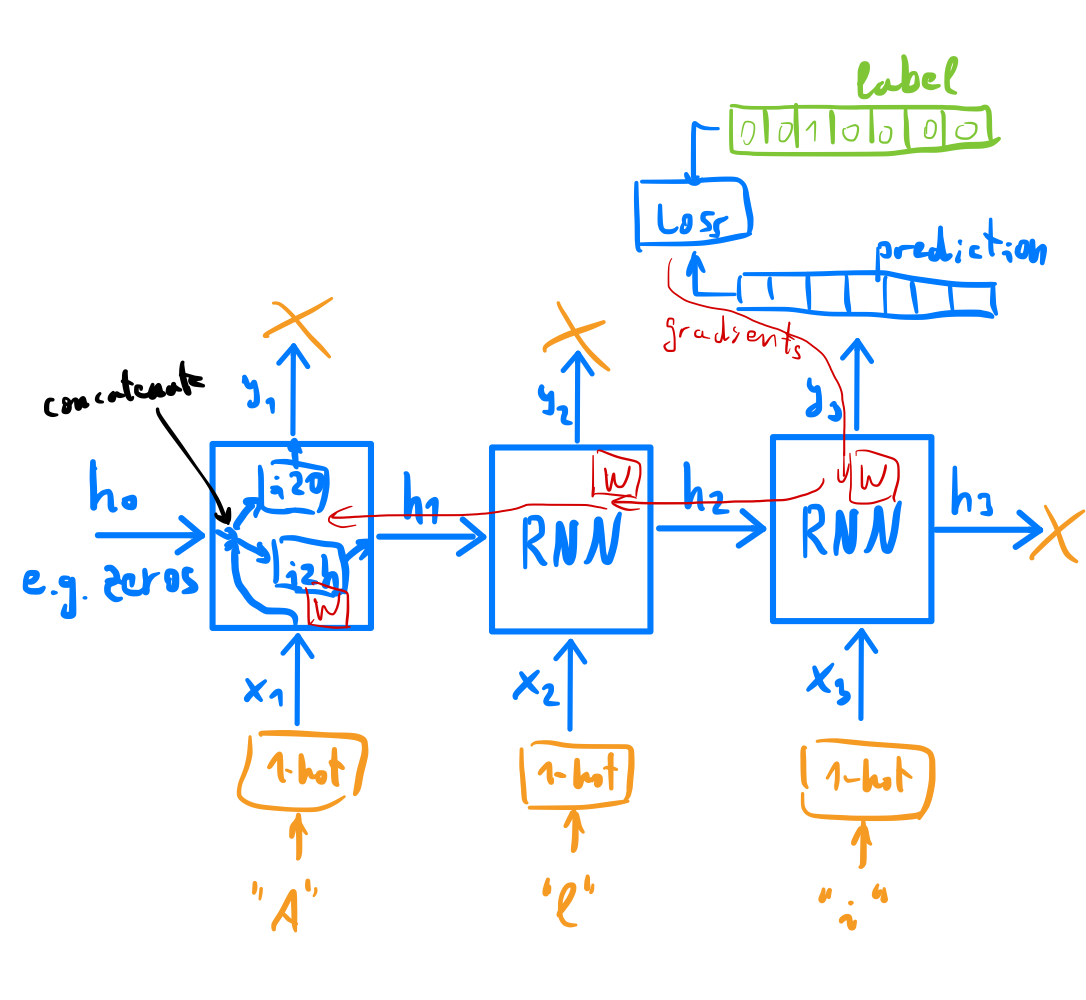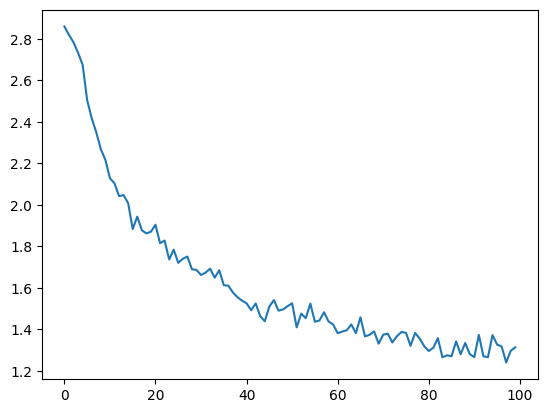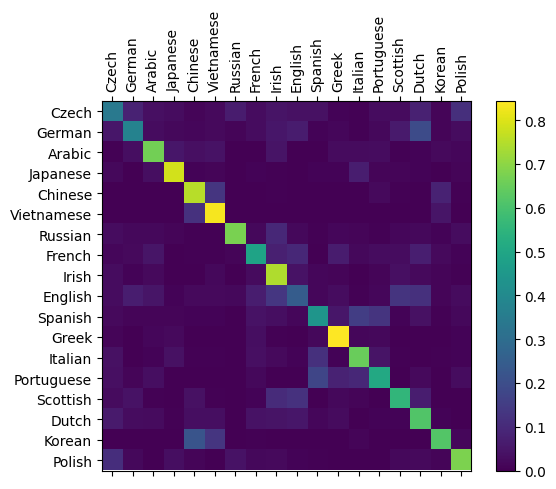7. Recurrent Neural Networks#
At the end of this exercise you will know how to:
Perform sequence classification with a character-level Recurrent Neural Network
And most importantly, you should gain a much better feeling for typical sequence modeling pipelines. The trained model will be able to predict which language a name originates from. This tutorial is heavily based on NLP From Scratch: Classifying Names with a Character-Level RNN.
We first have to begin by downloading the data
!wget https://download.pytorch.org/tutorial/data.zip
!unzip data.zip
# if you want to see the 10 top rows of one of these files, run:
# !head -n 10 data/names/Arabic.txt
Getting a dictionary, we then need to process the data
from __future__ import unicode_literals, print_function, division
from io import open
import glob
import os
def findFiles(path): return glob.glob(path)
print(findFiles('data/names/*.txt'))
import unicodedata
import string
all_letters = string.ascii_letters + " .,;'"
n_letters = len(all_letters)
# Turn a Unicode string to plain ASCII
def unicodeToAscii(s):
return ''.join(
c for c in unicodedata.normalize('NFD', s)
if unicodedata.category(c) != 'Mn'
and c in all_letters
)
# Build the category_lines dictionary, a list of names per language
category_lines = {}
all_categories = []
# Read a file and split into lines
def readLines(filename):
lines = open(filename, encoding='utf-8').read().strip().split('\n')
return [unicodeToAscii(line) for line in lines]
for filename in findFiles('data/names/*.txt'):
category = os.path.splitext(os.path.basename(filename))[0]
all_categories.append(category)
lines = readLines(filename)
category_lines[category] = lines
n_categories = len(all_categories)
['data/names/Czech.txt', 'data/names/German.txt', 'data/names/Arabic.txt', 'data/names/Japanese.txt', 'data/names/Chinese.txt', 'data/names/Vietnamese.txt', 'data/names/Russian.txt', 'data/names/French.txt', 'data/names/Irish.txt', 'data/names/English.txt', 'data/names/Spanish.txt', 'data/names/Greek.txt', 'data/names/Italian.txt', 'data/names/Portuguese.txt', 'data/names/Scottish.txt', 'data/names/Dutch.txt', 'data/names/Korean.txt', 'data/names/Polish.txt']
With this we now also have the number of categories in n_categories, and the complete list of considered languages in all_languages. Having this ASCII-stored data, we need to convert it into PyTorch Tensors, and represent them as “one-hot vectors”. What is a one-hot vector?
Consider the task of encoding the letter “b” in a one-hot vector. Then the direct solution would be to have a vector of the length of the alphabet with 0’s everywhere except at the 2nd position, where “b” is in the alphabet. This would constitute a one-hot encoding.
import torch
# Find letter index from all_letters, e.g. "a" = 0
def letterToIndex(letter):
return all_letters.find(letter)
# Just for demonstration, turn a letter into a <1 x n_letters> Tensor
def letterToTensor(letter):
tensor = torch.zeros(1, n_letters)
tensor[0][letterToIndex(letter)] = 1
return tensor
# Turn a line into a <line_length x 1 x n_letters>,
# or an array of one-hot letter vectors
def lineToTensor(line):
tensor = torch.zeros(len(line), 1, n_letters)
for li, letter in enumerate(line):
tensor[li][0][letterToIndex(letter)] = 1
return tensor
print(letterToTensor('J'))
print(lineToTensor('Jones').size())
tensor([[0., 0., 0., 0., 0., 0., 0., 0., 0., 0., 0., 0., 0., 0., 0., 0., 0., 0.,
0., 0., 0., 0., 0., 0., 0., 0., 0., 0., 0., 0., 0., 0., 0., 0., 0., 1.,
0., 0., 0., 0., 0., 0., 0., 0., 0., 0., 0., 0., 0., 0., 0., 0., 0., 0.,
0., 0., 0.]])
torch.Size([5, 1, 57])
Writing an RNN out as a combination of two feedforward layers
import torch.nn as nn
class RNN(nn.Module):
def __init__(self, input_size, hidden_size, output_size):
super(RNN, self).__init__()
self.hidden_size = hidden_size
self.i2h = nn.Linear(input_size + hidden_size, hidden_size)
self.i2o = nn.Linear(input_size + hidden_size, output_size)
self.softmax = nn.LogSoftmax(dim=1)
def forward(self, input, hidden):
combined = torch.cat((input, hidden), 1)
hidden = self.i2h(combined)
output = self.i2o(combined)
output = self.softmax(output)
return output, hidden
def initHidden(self):
return torch.zeros(1, self.hidden_size)
n_hidden = 128
rnn = RNN(n_letters, n_hidden, n_categories)
Recalling from the lecture, we then feed the network with a prompt tensor, \(x\) in the lecture, and then keeping the output token, as well as the altered hidden state which we would need at the next step to continue the computation. Every item will now contain the likelihood of a specific category.
input = lineToTensor('Albert')
hidden = torch.zeros(1, n_hidden)
output, next_hidden = rnn(input[0], hidden)
print(output)
tensor([[-2.7974, -2.9007, -2.9274, -2.8731, -2.8189, -3.0194, -2.7888, -2.9014,
-2.8996, -2.8004, -2.9938, -2.9044, -2.9080, -2.8285, -2.8810, -2.9778,
-2.8698, -2.9768]], grad_fn=<LogSoftmaxBackward0>)
We will then need a few last helper functions to instigate the training
def categoryFromOutput(output):
top_n, top_i = output.topk(1)
category_i = top_i[0].item()
return all_categories[category_i], category_i
print(categoryFromOutput(output))
('Russian', 6)
import random
def randomChoice(l):
return l[random.randint(0, len(l) - 1)]
def randomTrainingExample():
category = randomChoice(all_categories)
line = randomChoice(category_lines[category])
category_tensor = torch.tensor([all_categories.index(category)], dtype=torch.long)
line_tensor = lineToTensor(line)
return category, line, category_tensor, line_tensor
for i in range(10):
category, line, category_tensor, line_tensor = randomTrainingExample()
print('category =', category, '/ line =', line)
category = German / line = Mendel
category = Dutch / line = Haanraads
category = Russian / line = Hanenya
category = Spanish / line = Vargas
category = Russian / line = Verpeto
category = Greek / line = Alexandropoulos
category = Dutch / line = Haenraats
category = German / line = Brotz
category = Japanese / line = Kamon
category = Chinese / line = Miao
With which we can then set up the training where each loop of the training will:
Create input and target tensors
Create a zeroed initial hidden state
Reach each letter in, and retain the hidden state for the next letter
Compare the final output to the target output
Back-propagate the loss
Return the output and the loss
For example, we would get the following compute graph if we pass the name “Ali” to the network:

criterion = nn.NLLLoss()
learning_rate = 0.005
def train(category_tensor, line_tensor):
hidden = rnn.initHidden()
rnn.zero_grad()
for i in range(line_tensor.size()[0]):
output, hidden = rnn(line_tensor[i], hidden)
loss = criterion(output, category_tensor)
loss.backward()
# Add parameters' gradients to their values, multiplied by learning rate
for p in rnn.parameters():
p.data.add_(p.grad.data, alpha=-learning_rate)
return output, loss.item()
Now we can the actual timed training and keep track of its returned losses of which we only print every 1000th step.
import time
import math
n_iters = 100000
print_every = 5000
plot_every = 1000
# Keep track of losses for plotting
current_loss = 0
all_losses = []
def timeSince(since):
now = time.time()
s = now - since
m = math.floor(s / 60)
s -= m * 60
return '%dm %ds' % (m, s)
start = time.time()
for iter in range(1, n_iters + 1):
category, line, category_tensor, line_tensor = randomTrainingExample()
output, loss = train(category_tensor, line_tensor)
current_loss += loss
# Print iter number, loss, name and guess
if iter % print_every == 0:
guess, guess_i = categoryFromOutput(output)
correct = '✓' if guess == category else '✗ (%s)' % category
print('%d %d%% (%s) %.4f %s / %s %s' % (iter, iter / n_iters * 100, timeSince(start), loss, line, guess, correct))
# Add current loss avg to list of losses
if iter % plot_every == 0:
all_losses.append(current_loss / plot_every)
current_loss = 0
5000 5% (0m 2s) 1.5506 Chrysanthopoulos / Greek ✓
10000 10% (0m 4s) 1.8246 Courtemanche / French ✓
15000 15% (0m 6s) 2.6841 Fakhoury / Irish ✗ (Arabic)
20000 20% (0m 8s) 1.8530 Luong / Vietnamese ✓
25000 25% (0m 10s) 0.9614 Tighearnach / Irish ✓
30000 30% (0m 12s) 0.0129 Hishikawa / Japanese ✓
35000 35% (0m 14s) 1.3759 Puerta / Spanish ✓
40000 40% (0m 16s) 0.6204 Cai / Chinese ✓
45000 45% (0m 19s) 3.7291 Thomas / Arabic ✗ (French)
50000 50% (0m 21s) 2.3927 Leon / Chinese ✗ (French)
55000 55% (0m 23s) 0.7460 Nghiem / Vietnamese ✓
60000 60% (0m 25s) 0.3842 Kwang / Korean ✓
65000 65% (0m 27s) 5.4761 Fabian / Irish ✗ (Polish)
70000 70% (0m 29s) 1.9013 Hora / Japanese ✗ (Czech)
75000 75% (0m 31s) 0.9403 Medeiros / Portuguese ✓
80000 80% (0m 33s) 3.1636 Viner / German ✗ (English)
85000 85% (0m 35s) 1.6028 Loh / Vietnamese ✗ (Chinese)
90000 90% (0m 38s) 0.1875 Lefevre / French ✓
95000 95% (0m 40s) 0.3024 Antwerpen / Dutch ✓
100000 100% (0m 42s) 0.0443 Tsuruya / Japanese ✓
import matplotlib.pyplot as plt
import matplotlib.ticker as ticker
plt.figure()
plt.plot(all_losses)
[<matplotlib.lines.Line2D at 0x146ff21a0>]

As we are performing a classification, a direct assessment of the goodness classification is the confusion matrix for every language. For this the network is frozen, and samples are run through the network to obtain a set of predictions, and then assess the correctness of the predictions.
# Keep track of correct guesses in a confusion matrix
confusion = torch.zeros(n_categories, n_categories)
n_confusion = 10000
# Just return an output given a line
def evaluate(line_tensor):
hidden = rnn.initHidden()
for i in range(line_tensor.size()[0]):
output, hidden = rnn(line_tensor[i], hidden)
return output
# Go through a bunch of examples and record which are correctly guessed
for i in range(n_confusion):
category, line, category_tensor, line_tensor = randomTrainingExample()
output = evaluate(line_tensor)
guess, guess_i = categoryFromOutput(output)
category_i = all_categories.index(category)
confusion[category_i][guess_i] += 1
# Normalize by dividing every row by its sum
for i in range(n_categories):
confusion[i] = confusion[i] / confusion[i].sum()
# Set up plot
fig = plt.figure()
ax = fig.add_subplot(111)
cax = ax.matshow(confusion.numpy())
fig.colorbar(cax)
# Set up axes
ax.set_xticklabels([''] + all_categories, rotation=90)
ax.set_yticklabels([''] + all_categories)
# Force label at every tick
ax.xaxis.set_major_locator(ticker.MultipleLocator(1))
ax.yaxis.set_major_locator(ticker.MultipleLocator(1))
# sphinx_gallery_thumbnail_number = 2
plt.show()
/var/folders/3w/7v1njqbd2h10vfhnbwb23hth0000gn/T/ipykernel_34689/3585656379.py:33: UserWarning: FixedFormatter should only be used together with FixedLocator
ax.set_xticklabels([''] + all_categories, rotation=90)
/var/folders/3w/7v1njqbd2h10vfhnbwb23hth0000gn/T/ipykernel_34689/3585656379.py:34: UserWarning: FixedFormatter should only be used together with FixedLocator
ax.set_yticklabels([''] + all_categories)

A more direct test of our trained model is then running it with a bunch of sample prompts
def predict(input_line, n_predictions=3):
print('\n> %s' % input_line)
with torch.no_grad():
output = evaluate(lineToTensor(input_line))
# Get top N categories
topv, topi = output.topk(n_predictions, 1, True)
predictions = []
for i in range(n_predictions):
value = topv[0][i].item()
category_index = topi[0][i].item()
print('(%.2f) %s' % (value, all_categories[category_index]))
predictions.append([value, all_categories[category_index]])
predict('Toshev')
predict('Paehler')
predict('Adams')
> Toshev
(-0.29) Russian
(-2.74) Vietnamese
(-2.94) Korean
> Paehler
(-0.90) German
(-1.51) Dutch
(-2.31) French
> Adams
(-0.80) Arabic
(-1.80) Dutch
(-2.55) English
7.1. Tasks:#
a) Adapt this training to use the definitions of the RNN & LSTM we had in the lecture, train them, and compare the performance
b) Repeat this training with PyTorch’s native RNN-class
c) Repeat this training with PyTorch’s native LSTM-class
d) Increase the size of the network and see how this alters the performance.

